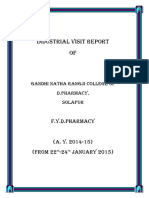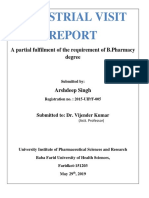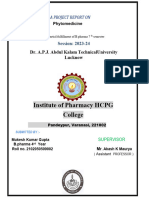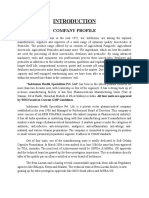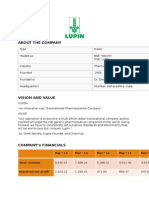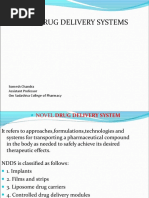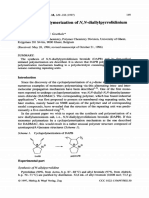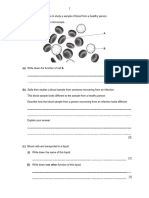0 ratings0% found this document useful (0 votes)
251 viewsDesign, Development and Evaluation of Econazole Nitrate Emulgel For Topical Fungal Disease
Design, Development and Evaluation of Econazole Nitrate Emulgel For Topical Fungal Disease
Uploaded by
Ihsanti Dwi RahayuThis document describes a dissertation protocol submitted by Deeshma K for a Master of Pharmacy degree. The proposed dissertation topic is the "Design, Development and Evaluation of Econazole Nitrate Emulgel for Topical Fungal Disease." Econazole nitrate is an antifungal drug currently available orally and via injection, but these routes have disadvantages. The objective is to develop an econazole nitrate emulgel for topical delivery to treat fungal infections of the skin while avoiding systemic absorption and side effects. A literature review was conducted and no previous work was identified on this specific topic.
Copyright:
© All Rights Reserved
Available Formats
Download as DOCX, PDF, TXT or read online from Scribd
Design, Development and Evaluation of Econazole Nitrate Emulgel For Topical Fungal Disease
Design, Development and Evaluation of Econazole Nitrate Emulgel For Topical Fungal Disease
Uploaded by
Ihsanti Dwi Rahayu0 ratings0% found this document useful (0 votes)
251 views18 pagesThis document describes a dissertation protocol submitted by Deeshma K for a Master of Pharmacy degree. The proposed dissertation topic is the "Design, Development and Evaluation of Econazole Nitrate Emulgel for Topical Fungal Disease." Econazole nitrate is an antifungal drug currently available orally and via injection, but these routes have disadvantages. The objective is to develop an econazole nitrate emulgel for topical delivery to treat fungal infections of the skin while avoiding systemic absorption and side effects. A literature review was conducted and no previous work was identified on this specific topic.
Original Title
04_P056_47383
Copyright
© © All Rights Reserved
Available Formats
DOCX, PDF, TXT or read online from Scribd
Share this document
Did you find this document useful?
Is this content inappropriate?
This document describes a dissertation protocol submitted by Deeshma K for a Master of Pharmacy degree. The proposed dissertation topic is the "Design, Development and Evaluation of Econazole Nitrate Emulgel for Topical Fungal Disease." Econazole nitrate is an antifungal drug currently available orally and via injection, but these routes have disadvantages. The objective is to develop an econazole nitrate emulgel for topical delivery to treat fungal infections of the skin while avoiding systemic absorption and side effects. A literature review was conducted and no previous work was identified on this specific topic.
Copyright:
© All Rights Reserved
Available Formats
Download as DOCX, PDF, TXT or read online from Scribd
Download as docx, pdf, or txt
0 ratings0% found this document useful (0 votes)
251 views18 pagesDesign, Development and Evaluation of Econazole Nitrate Emulgel For Topical Fungal Disease
Design, Development and Evaluation of Econazole Nitrate Emulgel For Topical Fungal Disease
Uploaded by
Ihsanti Dwi RahayuThis document describes a dissertation protocol submitted by Deeshma K for a Master of Pharmacy degree. The proposed dissertation topic is the "Design, Development and Evaluation of Econazole Nitrate Emulgel for Topical Fungal Disease." Econazole nitrate is an antifungal drug currently available orally and via injection, but these routes have disadvantages. The objective is to develop an econazole nitrate emulgel for topical delivery to treat fungal infections of the skin while avoiding systemic absorption and side effects. A literature review was conducted and no previous work was identified on this specific topic.
Copyright:
© All Rights Reserved
Available Formats
Download as DOCX, PDF, TXT or read online from Scribd
Download as docx, pdf, or txt
You are on page 1of 18
DESIGN, DEVELOPMENT AND EVALUATION OF ECONAZOLE
NITRATE EMULGEL FOR TOPICAL FUNGAL DISEASE
MASTER OF PHARMACY DISSERTATION PROTOCOL
SUBMITTED TO THE
RAJIV GANDHI UNIVERSITY OF HEALTH SCIENCES KARNATAKA,
BANGALORE.
BY
DEESHMA.K
B.Pharm
Under The Guidance of
Dr.A.R.SHABARAYA
M.Pharm, MBA, Ph.D
DEPARTMENT OF PHARMACEUTICS.
SRINIVAS COLLEGE OF PHARMACY, VALACHIL, MANGALORE 574143
2013-2015
RAJIV GANDHI UNIVERSITY OF HEALTH SCIENCES
BANGALORE, KARNATAKA
ANNEXURE-II
PROFORMA FOR REGISTRATION OF SUBJECTS FOR DISSERTATION
1.
Name of the Candidate and
Address:
MS. DEESHMA.K
1
st
YEAR M.PHARM,
DEPT. OF PHARMACEUTICS,
SRINIVAS COLLEGE OF PHARMACY,
VALACHIL, MANGALORE-574143.
2.
Name of the Institution:
SRINIVAS COLLEGE OF PHARMACY,
VALACHIL, FARANGIPETE POST,
MANGALORE-574143.
3.
Course of Study and Subject:
MASTER OF PHARMACY
(PHARMACEUTICS)
4.
Date of Admission:
25-7-2013
5.
Title of the Project:
DESIGN, DEVELOPMENT AND EVALUATION OF
ECONAZOLE NITRATE EMULGEL FOR TOPICAL FUNGAL
DISEASE
6.
Brief Resume of the intended work:
6.1 Need of the study:
Topical drug delivery can be defined as the application of a drug containing
formulation to the skin to directly treat cutaneous disorder. Topical drug
administration is a localized drug delivery system anywhere in the body
through ophthalmic, rectal, vaginal and skin as topical routes. Transdermal
drug delivery is an attractive route for local and systemic treatment. Topical
preparations pertain to medicaments applied to the surface of a part of a body
and are a term used to describe formulations that have effects only in a
specific area of the body and are formulated in such a manner that the
systemic absorption of medicament is minimal. Transdermal drug delivery
offers several advantages over conventional route. Most common examples
of topical dosage forms include solution, suspensions, emulsions, semisolids,
spray etc
1
.
Within the major group of semisolid preparations, the use of transparent gels
has expanded both in cosmetics and in pharmaceutical preparations. Gels are
a relatively newer class of dosage form created by entrapment of large
amounts of aqueous or hydroalcoholic liquid in a network of colloidal solid
particles, which may consist of inorganic substances, such as aluminium
salts or organic polymers of natural or synthetic origin. They have a higher
aqueous component that permits greater dissolution of drugs, and also permit
easy migration of the drug through a vehicle that is essentially a liquid,
compared with the ointment or cream base. These are superior in terms of
use and patient acceptability. In spite of many advantages of gels a major
limitation is in the delivery of hydrophobic drugs. So to overcome this
limitation, emulgels are prepared and used so that even a hydrophobic
therapeutic moiety can enjoy the unique properties of gels
2
.
When gels and emulsions are used in combined form the dosage forms are
referred as emulgels. As the name suggest they are the combination of
emulsion and gel. In recent years, there has been great interest in the use of
novel polymers with complex functions as emulsifiers and thickeners
because the gelling capacity of these compounds allows the formulation of
stable emulsions and creams by decreasing surface and interfacial tension
and at the same time increasing the viscosity of the aqueous phase. In fact,
the presence of a gelling agent in the water phase converts a classical
emulsion into an emulgel. Both oil-in-water and water-in-oil emulsions are
used as vehicles to deliver various drugs to the skin. Emulsions possess a
certain degree of elegance and are easily washed off whenever desired. They
also have a high ability to penetrate the skin. Emulgels for dermatological
use have several favorable properties such as being thixotropic, greaseless,
easily spreadable, easily removable, emollient, nonstaining, water-soluble,
longer shelf life, bio-friendly, transparent & pleasing appearance
3
.
Superficial fungal infections are among the most widespread diseases known
to man. They target the parts of the body as diverse in form and function as
the skin, the nail, the buccal cavity, the eye and the vagina. Fungistatic azole
drugs, that is, imidazole and triazole-containing compounds, have been the
mainstay of antifungal therapy for many years. The imidazole derivative
econazole nitrate is effective in treating Candida albicans infections
4
.
Econazole nitrate is an antifungal agent which belongs to imidazole derivate
ring structure. The spectrum of activity includes dermatophytes, candida,
yeasts, dimorphic fungi and gram-positive bacteria. Its mechanism of action
may involve inhibition of membrane enzymes, including cytochrome P450,
and lipid biosynthesis. The bactericidal and inhibitory effects of several
azole antifungal compounds, including econazole nitrate against
Mycobacterium segmatis has been investigated. No significant side-effects or
adverse effects have been recorded with this compound either during drug
safety trials or during clinical use, among pregnant and non-pregnant
patients
5
.
Econazole nitrate is available commercially as tablets and injections, in spite
of its well known adverse effects including nausea, vomiting, bloating, and
abdominal discomfort. Oral econazole cannot be taken in conjunction with a
number of medications. In order to bypass these disadvantages, the topical
emugel formulations have been proposed. The aim of the present research
work is to design, develop and evaluate econazole nitrate emulgel for topical
fungal disease
6
.
Advantages of emulgel
Hydrophobic drugs can be easily incorporated into gels using o/w
emulsions.
Suitable for drug with short half life & potent drug.
Site specific drug delivery.
Avoidance of first pass metabolism.
Medication can be self applied.
Improve patient compliance.
Better stability& loading capacity.
6.2 Review of literature:
Exhaustive literature survey was carried out on the proposed topic using
Internet, RGUHS (Helinet Consortium) and referring journals. The survey reveals
that no work has been carried out on the proposed topic and some related work is
quoted below
Ankur Jain, Surya P Gautham, Yashwanth Gupta, Hemanth Khambete,
Sanjay Jain
7
has developed and characterized ketaconazole emulgel for
topical drug delivery. Emulgel formulations of ketoconazole were prepared
using 2 types of gelling agents: Carbopol 934 and Carbopol 940. All the
prepared emulgel showed acceptable physical properties concerning color,
homogeneity, consistency, spreadability and pH value. The highest
antifungal activity was observed with F1 and F3 (both containing carbopol
934 as gelling agent), where the percentage inhibition was found to be 47.5
1.15 % and 46.6 1.34% respectively, as compared marketed product
which was found 34.431.06 %. No skin irritation was observed on the
rabbits. They finally concluded that the emulgel formulation succeed the
drug release for sustained drug delivery in a controlled manner in
comparison with marketed cream.
Rachit Kullar, Deepinder Kumar, Nirmatha Seth, Seema Saini
8
has
formulated and evaluated mefenamic acid emugel for topical delivery.
Emulgel of mefenamic acid was prepared by using Carbapol 940 as a gelling
agent. Mentha oil and clove oil were used as penetration enhancers. The
emulsion was prepared and it was incorporated in gel base. The formulations
were evaluated for rheological studies, spreading coefficient studies,
bioadhesion strength, skin irritation studies, in-vitro release, ex-vivo release
studies, anti-inflammatory activity and analgesic activity. Formulation F2
(6% w/w mentha oil) and F4 (10% w/w clove oil) showed comparable
analgesic and anti-inflammatory activity when they compare with marketed
diclofenac sodium gel. The study concluded that topical emulgel of
mefenamic acid posses an effective anti-inflammatory and analgesic activity.
Dignesh M Khunt, Ashish D Mishra, Dinesh R Shah
9
has formulated,
designed and evaluated piroxicam emulgel. The emulgels were prepared
using different combinations of oil, emulsifiers, co-surfactant and carbomer
(Carbopol 940 and Carbopol 934). They were optimized using 3
2
full
factorial designs to study the effect of independent variables. The optimized
formulations were found to be F3 and F12 containing lower concentration of
Carbopol (0.5%) and higher concentration of emulsifiers (6%). The
optimized formulae were evaluated for zeta Potential, viscosity,
spreadability, skin permeation and stability. Skin permeation (%) of
optimized batches (F3 and F12) in 24hrs was found to be 87.89% and 89.09
% respectively & they concluded that formulation batch F12 (carbopol 934)
had better anti-inflammatory activity than marketed preparation.
Kaushal R Sabu, Ganesh D Basarkar
10
has formulated developed &
evaluated in-vitro studies of terbinafine hydrochloride for topical anti-fungal
activity. All the prepared emulgels showed satisfactory physicochemical
properties like color, homogeneity, consistency, spreadability, and pH value.
The drug release was found to be higher for optimized formulation as
compared to the marketed terbinafine hydrochloride cream. The highest drug
release was observed with E4 ( contains Liquid paraffin -8.0%w/w, Span 20-
2.5%w/w & Tween 20-1%w/w) where the drug release showed 93.23% at
24hrs as compared to marketed terbinafine hydrochloride cream was found
94.17% at 8hrs. The drug release from all the emulgels was found to follow
diffusion-controlled mechanism. Stability studies indicated that the physical
appearance, rheological properties, spreadability, drug release in all the
prepared emulgels remained unchanged upon storage 3 months. From the
study they concluded that terbinafine hydrochloride emulgel can be
formulated as topical antifungal agent.
Yehia Khalil, Abheer H Khasraghi, Entidhar J Mohemmed
11
has
prepared and evaluated the physical and rheological study of clotrimazole
emulgel. The influence of the type of gelling agent (carbopol 934 and
methyl cellulose), the concentration of both the emulsifying agent (2% and
4% w/w of mixture of span 20 and tween 20) and the oil phase (5% and
7.5% w/w of liquid paraffin) and the type of oil phase (liquid paraffin and
cetyl alcohol) on the drug release from the prepared emulgels was
investigated. Rheological studies revealed that all emulgels formulations
exhibited a shear thinning behaviour with thixotropy, indicating structural
break down of intermolecular interaction between polymeric chains.
Clotrimazole emulgels exhibited higher drug release than marketed cream.
The results of in vitro release showed that methyl cellulose based emulgel
gave better release than carbopol 934 based one. From the study finally
they concluded that the clotrimazole can be formulated as emulgel with a
proper consistency, exhibiting shear-thinning behaviour with thixotropy, and
good release which follows Higuchi diffusion model.
Monica Rao, Girish Sukre, Sheetal Aghav, Manmeet Kumar
12
has
developed and optimized metranidazole emulgel. Pseudoternary phase
diagrams were developed for various microemulsion formulations composed
of Capmul 908-P, Acconon MC8-2 EP, and propylene glycol. The emulgel
was optimized using a three-factor, two-level factorial design, the
independent variables selected were Capmul 908 P, and surfactant mixture
(Acconon MC8-2 and gelling agent), and the dependent variables
(responses) were a cumulative amount of drug permeated across the dialysis
membrane in 24 hr and spreadability . Validation of the optimization study
with 3 confirmatory runs indicated a high degree of prognostic ability of
response surface methodology. Finally, they concluded that emulgel system
of metranidazole was developed and optimized using 2
3
factorial design and
could provide an effective treatment against topical infections.
Khaled M Hosny, Shatha M Rambo, Muna M Al-Zahrani, Samia M Al-
Subhi, Usama A Fahmi
13
has characterized & pharmacodynamically
evaluated ketoprofen emulgel. Hydroxypropyl celluloses (HPC) and
hydroxylpropylmethyl celluloses (HPMC) were the two polymers used as
gelling agents. Oleic acid, tween, carveol, terpene and isopropyl alcohol
were used as penetration enhancers, and effect of these enhancers on
diffusion of ketoprofen a cross semi-permeable membrane was tested.
Results revealed that the emulgel formulations exhibited high drug release
especially at low polymer concentration and the release was follow diffusion
controlled mechanism. All enhancers showed enhancement in ketoprofen
penetration specially the optimized formula contain ketoprofen 2%, HPC
2%, and 5% Oleic acid which exhibited improved anti-inflammatory activity
compared to commercially available gel. So finally they concluded that
topical emulgel enhanced permeation of ketoprofen and possed an effective
anti-inflammatory activity, with avoidance of GIT adverse effect.
Shingala Vikas, Saini Seema, Rana AC, Singh Gurpreet
14
has developed
and evaluated topical emulgel of lornoxicam using different polymer bases
like Carbopol 934, Carbopol 940 and HPMC K4M. The influence of the type
of the gelling agent on the drug release from the prepared emulgel was
investigated. The mentha oil is used as permeation enhancer. The prepared
emulgel were evaluated for their physical appearance, pH determination,
viscosity, spreadability, in vitro drug release, ex vivo drug release, skin
irritation test, anti inflammatory activity, analgesic activity and stability
studies. All the prepared formulations showed acceptable physical
properties, consistency, spreadability, viscosity and pH value. The best
formulation F1 (carbopol 940) and F4 ( cabopol 934) showed comparable
analgesic and anti inflammatory activity when they compared with marketed
diclofenac sodium gel. The in vitro release rate of emulgel was evaluated
using diffusion cell containing dialysis membrane with phosphate buffer pH
7.4 as the receptor medium. The release rate of the emulgel was found to
obey Higuchi model. So finally they concluded that lornoxicam emulgel can
be used as an anti-inflammatory and analgesic agent for topical drug
delivery.
Piyusha Deveda, Ankur Jain, Naveen Vyas, Hemant Khambete, Sanjay
Jain
15
has developed a gellified emulsion for sustain delivery of itraconazole
for topical fungal disease. In this work they prepared emulsion and then
incorporated in carbapol gel & optimized by using 2
3
factorial designs. The
result of studied revealed that the optimized batch shows 95.08% release in
48 hrs and stable for around three. The result of microbial assay compared
with marketed product, the result shows 46.6% inhibition of optimized batch
where as marketed preparation shows only 32.3% inhibition. While result of
skin irritation test shows no edema and erythema. Hence it can be concluded
that emulsion based system is more effective and safe system for sustain
delivery of antifungal agent(s).
Magdy I Mohamed
16
have optimized chlorphenesin emulgel formulation.
They developed chlorphenesin (CHL) emulgel using 2 types of gelling agent
hydroxypropylmethyl cellulose (HPMC) and Carbopol 934. The influence of
the type of the gelling agent and the concentration of both the oil phase and
emulsifying agent on the drug release from the prepared emulgels was
investigated using a 2
3
factorial design. All the prepared emulgels showed
acceptable physical properties concerning color, homogeneity, consistency,
spreadability, and pH value. They also exhibited higher drug release and
antifungal activity than the CHL powder. As a general conclusion, it was
suggested that the CHL emulgel formulation prepared with HPMC with the
oil phase concentration in its low level and emulsifying agent concentration
in its high level was the formula of choice since it showed the highest drug
release and antifungal activity.
6.2 Objectives of the study:
The objective of the study is to design, development & evaluate emulgel containing
econazole nitrate (antifungal agent) for topical skin infections.
Specific objectives of the present investigation are as follows:
To evaluate with respect to drug excipient interaction studies (FTIR).
To carry out preformulation studies of the ecconazole nitrate.
To design and develop econazole nitrate emulgel by using various
gelling agent by suitable method.
To carry out evaluation of formulated econazole nitrate emulgel.
To carry out stability studies as per ICH guidelines.
Materials and Methods:
Materials:
1. Drug : Econazole nitrate
2. Excipients :
Polymers :-
Synthetic polymers: HPMC 2910, HPMC K
4
M etc.
Natural polymers : Xanthan gum, Guar gum etc
Gelling agent: - Carbopol 931, Carbopol 940 etc.
Oils: - Light liquid paraffin, Capmul, Propylene glycol etc.
Emulsifiers: - Span 80, Tween 80, Stearic acid etc.
Penetration enhancers: - Oleic acid, Lecithin, Menthol, clove oil etc.
All other chemicals will be used of analytical grade.
7.
Methods:
Emulgel will be prepared by the method reported by Mohammed et al (2004) with
minor modification.
Step 1: Formulation of emulsion either W/O or O/W.
The oil phase of the emulsion will be prepared by dissolving Span 20 in light liquid
paraffin while the aqueous phase will be prepared by dissolving Tween 20 in
purified water. Methyl and Propyl paraben will be dissolved in propylene glycol
whereas drug was dissolved in ethanol and both solutions will be mixed with the
aqueous phase. Both the oily and aqueous phases will be separately heated to 70 to
80C; then the oily phase will be added to the aqueous phase with continuous
stirring until cooled to room temperature.
Step 2: Formulation of gel base by dispersing a gelling agent in purified water with
constant stirring at a moderate speed & pH is adjusted.
Step 3: Incorporation of emulsion in gel base with continuous stirring.
7.1 Source of data:
1.Review of literature from
a) Journals such as :-
International Journal of Pharma Professionals Research.
International journal of pharm tech research.
Scholar research library.
International journal of pharm tech research.
International journal of pharm. research and development.
South African Medical Journal.
International journal of pharmacy and pharmaceutical sciences.
Journal of Innovative trends in pharmaceutical sciences.
Scholar research library.
Asian journal of pharmaceutical and clinical research.
International journal of pharmacy and pharmaceutical sciences.
Indian journal of pharmaceutical education and research.
International Quarterly Research Journal of Chemical Sciences.
( Rasayan journal)
American Association of Pharmaceutical Scientists journal.
International Journal of Drug Delivery.
b) Internet Browsing.
c) Laboratory based studies.
d) CD-ROM search.
2. Laboratory based experiments and evaluation.
7.2 Method of Collection of Data:
1. The data related to properties of the drug & emulgel will be collected from
drug information centre, various standard books, journals & other sources like
research literature data bases such as science direct etc. and laboratory experiment.
2. Formulation of topical emulgel.
3. Evaluation of formulated Topical emulgel , as follows:
Drug and excipients interaction by FTIR spectroscopy
Physical examination
9,14
pH measurement
14
Rheological studies
11,16
Transmission electron microscopy
7
Average globule size & its distribution
7
Extrudability study of the topical emulgel
7
Swelling index
17
Drug content determination
17
In- vitro drug release study
8,12
Drug release kinetic studies
9,10,12,13
Ex-vivo drug release study
10
Spreadability
10,14
Ex-vivo bioadhesive strength measurement of topical emulgel
17
Microbiological assay
15,16
Skin irritation test
7
Stability studies as per ICH guideline
10,15
7.3 Does the study require any investigations or interventions to be Conducted
on patients or other humans or animals? If so, please describe briefly.
- yes.
7.4 Has ethical clearance been obtained from your institution in case of 7.3?
- yes.
Ref: SCP/CPCSEA/P13/F202/2013
List of references:
1. Joshi B, Singh G, Rana AC, Saini S, Singla V. Emulgel: A comprehensive
review on the recent advances in topical drug delivery. Int Res J Pharm
2011;2(11):66-70.
2. Dadwal M. Emulgel: A novel approach to topical drug delivery. Int J Pharm
Bio Sci 2013 jan;4(1):847-56.
3. Rachit K, Saini S, Seth N, Rana AC. Emulgel: A surrogate apporoach for
topically used hydrophobic drug. Int J Pharm Bio Sci 2011 july-
sept;1(3):117-28.
4. Pfaller MA, Sutton DA. In-vitro activity of sertaconazole nitrate in the
treatment of superficial fungal infections. Diagnostic microbiology and
infectious disease 2006;56:147-52.
5. Bloch B, Kretzel A. Econazole nitrate in the treatment of candidal vaginitis.
S A Med J 1980;23:314-7.
6. Mitkari BV, Korde SA, Mahadik K, Kokare CR. Formulation and
evaluation of topical liposomal gel for fluconazole. Indian J Pharm Educ Res
2010;44(1):324-32.
7. Ankur J, Surya PG, Yashwant G, Hemant K, Sanjay J. Development &
characterization of ketoconazole emulgel for topical drug delivery. Der
Pharmacia Sinica 2010;1(3):221-31.
8. Rachit K, Deepinder K, Nirmatha S, Seema S. Formulation and evaluation
of mefenamic acid emugel for topical delivery. Saudi Pharma J 2012;20:63-
7.
9. Dignesh MK, Ashish DM, Dinesh RS. Formulation design and evaluation of
8.
piroxicam emulgel. Int J Pharm Tech Res 2012;4(3):1332-44.
10. Kaushal RS, Ganesh DB. Formulation, development & In-vitro evaluation of
terbinafine hydrochloride for topical anti-fungal activity. Int J Pharm Sci Rev
Res 2013 July-Aug;21(2):168-73.
11. YehiaI K, Abheer HJ, Entidhar JM. Preparation and evaluation of physical
and rheological study of clotrimazole emulgel. Iraqui J Pharm Sci
2011;20(2):6-10
12. Monica R, Girish S, Sheetal A, Manmeet K. Development and optimization
of metranidazole emulgel. J Pharmacy 2013;1-9.
13. Khaled MH, Shatha MR, Muna M A, Samia MS, Usama AF. Ketoprofen
emulgel: Preparation, characterization & pharmacodynamic evaluation. Int J
Pharm Rev Res 2013 May-June;20(2):306-10.
14. Shingala V, Saini S, Rana AC, Singh G. Development and evaluation of
topical emulgel of lornoxicam using different polymer bases. Int Pharm Sci
2012;2(3):36-44.
15. Piyusha D, Ankur J, Naveen V, Hemant K, Sanjay J. Gellified emulsion for
sustain delivery of itraconazole for topical fungal diseases. Int J Pharmacy
Pharm Sci 2010;2(1):104-12.
16. Magdy IM. Optimization of chlorphenesin emulgel formulation. The AAPS
J 2004;6(3):1-7.
17. Rachit K, Saini S, Seth N, Rana AC. Emulgels: a surrogate approach for
topically used hydrophobic drugs. Int J Pharmacy Bio Sci 2011;1(3):117-28.
9.
Signature of the candidate
(DEESHMA.K)
10.
Remarks of the Guide
The work, which is assigned to
DEESHMA.K is under my guidance.
11.
11.1 Name and Designation of the
Guide
Dr.A.R. SHABARAYA
M.pharm, MBA, Ph.D.
Principal & director
Srinivas College of Pharmacy
Valachil, Mangalore- 574143
11.2 Signature
11.3 Name and Designation of the
Co-Guide
---------------
11.4 Signature
---------------
11.5 Head of the Department
Dr. A. R. SHABARAYA
M.Pharm, MBA, Ph.D.
Head of the department
Srinivas College of Pharmacy,
Valachil, Mangalore- 574143
11.6 Signature
12.
12.1 Remarks of the Principal
Recommended and forwarded for
favourable consideration.
12.2 Signature
Dr. A. R. SHABARAYA
You might also like
- Stricon Pharma PVT LTD BangloreDocument58 pagesStricon Pharma PVT LTD BangloreShanu SatheesanNo ratings yet
- Summer Internship ProjectDocument52 pagesSummer Internship ProjectRajat SarkarNo ratings yet
- Introduction To Nuclear Physics and ApplicationsDocument118 pagesIntroduction To Nuclear Physics and ApplicationsPhysics Tomorrow100% (2)
- Industrial Visit Report-SG Phyto Pharma Pvt. LTD - Kolhapur. (2014-15)Document9 pagesIndustrial Visit Report-SG Phyto Pharma Pvt. LTD - Kolhapur. (2014-15)renugarenuga299No ratings yet
- Industrial Training ReportDocument17 pagesIndustrial Training ReportKumar AvinashNo ratings yet
- PROJECT REPORT On MicroencapsulationDocument33 pagesPROJECT REPORT On MicroencapsulationKrish RajNo ratings yet
- F TanmayprojectDocument38 pagesF TanmayprojectTanmay WalunjNo ratings yet
- Share Training ReportDocument50 pagesShare Training ReportHimanshu bishtNo ratings yet
- Floating ZahidDocument49 pagesFloating ZahidShobhit GoswamiNo ratings yet
- CPCSEA and Form BDocument21 pagesCPCSEA and Form Bashutosh kumar YadavNo ratings yet
- Olive Oil and Clove Oil Based Nanoemulsion For Topical Delivery of Terbinafine Hydrochloride in Vitro and Ex Vivo EvaluationDocument14 pagesOlive Oil and Clove Oil Based Nanoemulsion For Topical Delivery of Terbinafine Hydrochloride in Vitro and Ex Vivo EvaluationRaghavendra NaveenNo ratings yet
- Industrial Training ReportDocument34 pagesIndustrial Training Reportharshjoshi121203No ratings yet
- Final Project Anti BacterialDocument25 pagesFinal Project Anti BacterialSaurabh MaratheNo ratings yet
- Hospital Training-2-1Document37 pagesHospital Training-2-1yashdevsingh4414No ratings yet
- Industrial Report SaurabhDocument36 pagesIndustrial Report SaurabhSmart IndianNo ratings yet
- Industrial Training ReportDocument15 pagesIndustrial Training ReportcgoldcafeNo ratings yet
- Mahendra Labs Private Limited: Summer Vocational Training ReportDocument32 pagesMahendra Labs Private Limited: Summer Vocational Training ReportAnish KallolkarNo ratings yet
- Wa0000.Document58 pagesWa0000.Anahita PutulNo ratings yet
- B.Pharm 7th Semester SyllabusDocument12 pagesB.Pharm 7th Semester Syllabusansariazh7No ratings yet
- Noble Drug Delivery System Project Report For LrietDocument25 pagesNoble Drug Delivery System Project Report For LrietAshish NavalNo ratings yet
- Investigational New Drug Application (INDA)Document25 pagesInvestigational New Drug Application (INDA)Mallikarjun MangapuramNo ratings yet
- Spray Bandage Strategy in Topical Drug DeliveryDocument9 pagesSpray Bandage Strategy in Topical Drug DeliveryUday BaruahNo ratings yet
- Industrial TrainingDocument12 pagesIndustrial TrainingArshNo ratings yet
- Alkem Corporate PPT - PartnersDocument24 pagesAlkem Corporate PPT - PartnersSujeetbardhan0% (1)
- Practice School ReportDocument21 pagesPractice School Reportsatyamv3452No ratings yet
- CTD & eCTD, Industry & FDA Liasions: Shivangi Verma Dr. Sanjiv Kumar ChaudhriDocument26 pagesCTD & eCTD, Industry & FDA Liasions: Shivangi Verma Dr. Sanjiv Kumar ChaudhriShivangi VermaNo ratings yet
- Pharmaceutical and Software Development ProjectsDocument6 pagesPharmaceutical and Software Development ProjectsAlexandar123No ratings yet
- MukeshDocument28 pagesMukeshchoudhary25092000No ratings yet
- Industry ReportDocument26 pagesIndustry ReportRudra PangeniNo ratings yet
- Pharmaceutics - Chapter-1: History of The Profession of Pharmacy in India in Relation To Pharmacy Education, IndustryDocument15 pagesPharmaceutics - Chapter-1: History of The Profession of Pharmacy in India in Relation To Pharmacy Education, IndustryManishNo ratings yet
- Company Profile: "Indchemie Health Specialities Pvt. LTD" Has Been in The Ethical Pharma Business ForDocument8 pagesCompany Profile: "Indchemie Health Specialities Pvt. LTD" Has Been in The Ethical Pharma Business ForKrishnaSinghNo ratings yet
- Gujarat Technological University: W.E.F. AY 2017-18Document2 pagesGujarat Technological University: W.E.F. AY 2017-18raj royelNo ratings yet
- Pharmacy Project ADocument28 pagesPharmacy Project Aknnumeena2003No ratings yet
- Prashant Pps Front PgesDocument6 pagesPrashant Pps Front PgesM. Shoeb Sultan100% (2)
- Practice SchoolDocument17 pagesPractice Schoolsharpplay675No ratings yet
- Herbal Soap Project-2Document48 pagesHerbal Soap Project-2Sai krishna PoojithaNo ratings yet
- Samarjit Thesis-1Document16 pagesSamarjit Thesis-1himanshubehera73No ratings yet
- Experiment T2: Chromatographic Purity Profiling of A Sample of Paracetamol Pure Substance Aims and ObjectivesDocument3 pagesExperiment T2: Chromatographic Purity Profiling of A Sample of Paracetamol Pure Substance Aims and Objectivesjontusiire67% (3)
- Preparation and Evaluation of Herbal Cold Cream With Incorporated Curcuma LongaDocument3 pagesPreparation and Evaluation of Herbal Cold Cream With Incorporated Curcuma LongaInternational Journal of Innovative Science and Research TechnologyNo ratings yet
- Practice School - Bhavya PDFDocument25 pagesPractice School - Bhavya PDFBhavyaNo ratings yet
- Report On Industrial Training at Goldfish: PHARMA PVT - LTD (Kukatpally, Hyderabad)Document25 pagesReport On Industrial Training at Goldfish: PHARMA PVT - LTD (Kukatpally, Hyderabad)Ramya G100% (1)
- Indian Pharmacopoeia Commission Structure and Role in Formulation of IP and NFI PDFDocument5 pagesIndian Pharmacopoeia Commission Structure and Role in Formulation of IP and NFI PDFRajesh KumarNo ratings yet
- Recruitment, Training, Evaluation & Compensation To A PharmacistDocument15 pagesRecruitment, Training, Evaluation & Compensation To A PharmacistDR.MAHESHNo ratings yet
- Unit-I Industrial Pharmacy-II, VII SemDocument49 pagesUnit-I Industrial Pharmacy-II, VII SemRamandeep Kaur BaathNo ratings yet
- Review in Pharmaceutical PolymerDocument29 pagesReview in Pharmaceutical PolymerVinod ChandraNo ratings yet
- Project On Lupin PhrmaDocument47 pagesProject On Lupin PhrmaUmesh AmanNo ratings yet
- Internship Report of Pharmaceutical IndustryDocument39 pagesInternship Report of Pharmaceutical IndustryAhmad HassanNo ratings yet
- Lupin Limited A Detailed ReportDocument3 pagesLupin Limited A Detailed ReportAshokKumar100% (1)
- Sales Forecasting, Budget and Cost Control: Presented byDocument24 pagesSales Forecasting, Budget and Cost Control: Presented byArpan PalNo ratings yet
- 1.JATIN .Formulation and Evaluation of Herbal Antia-Cne Face PackDocument21 pages1.JATIN .Formulation and Evaluation of Herbal Antia-Cne Face PackIshwarjit SinghNo ratings yet
- altrenative med practice schoolDocument26 pagesaltrenative med practice schoolvishesh01052004No ratings yet
- Formulation and Evaluation of Pulsatile Drug Delivery SystemDocument25 pagesFormulation and Evaluation of Pulsatile Drug Delivery SystemAshish NavalNo ratings yet
- Report On Industrial TrainingDocument18 pagesReport On Industrial Trainingworkvasudha18No ratings yet
- Hospital TrainingDocument28 pagesHospital Traininggamerrdx000No ratings yet
- NDDSDocument17 pagesNDDSsomesh chandraNo ratings yet
- Industrial Training ReportDocument23 pagesIndustrial Training ReportRajeev KumarNo ratings yet
- Deepu Pps Front PgesDocument6 pagesDeepu Pps Front PgesM. Shoeb SultanNo ratings yet
- Code of MarketingDocument160 pagesCode of MarketingShimul HalderNo ratings yet
- Industrial Pharmacy - CoatingDocument16 pagesIndustrial Pharmacy - CoatingSolomonNo ratings yet
- cm117 2Document162 pagescm117 2B'Thaveephone DsngNo ratings yet
- Mechanical Performance of Additively Manufactured Meta-BiomaterialsDocument19 pagesMechanical Performance of Additively Manufactured Meta-Biomaterialsberk baris celikNo ratings yet
- Thesis Pumpless Ice Thermal StorageDocument55 pagesThesis Pumpless Ice Thermal StorageMoiz TinwalaNo ratings yet
- Profile of Maruti SaptaleDocument4 pagesProfile of Maruti SaptalesaptaleNo ratings yet
- Iron - WikipediaDocument20 pagesIron - Wikipediaramthecharm_46098467No ratings yet
- Inorganic Laboratory ManualDocument8 pagesInorganic Laboratory ManualDhika AmeliaNo ratings yet
- Síntese e Polimerização de Brometo de N, N - DialilpirrolidínioDocument8 pagesSíntese e Polimerização de Brometo de N, N - DialilpirrolidínioHeloisa Gabriele Miranda da SilvaNo ratings yet
- Protein MarkersDocument1 pageProtein MarkersMónika Whiltierna SzenykivNo ratings yet
- Chlor Rid SlidesDocument47 pagesChlor Rid Slidesmohammed goudaNo ratings yet
- BaOH2 PDFDocument5 pagesBaOH2 PDFGhana Cintai DiaNo ratings yet
- Well DisinfectionDocument2 pagesWell DisinfectionDiannaDZNo ratings yet
- Composites FinalDocument71 pagesComposites FinalBnNo ratings yet
- Chemistry of Crudes - DR y K SharmaDocument48 pagesChemistry of Crudes - DR y K Sharmasuprateem100% (1)
- A.gowtham Chemistry Investigation Project 2024-25Document23 pagesA.gowtham Chemistry Investigation Project 2024-25agowtham506No ratings yet
- PM/ IS 2046/ 1/ April 2019: Bureau of Indian StandardsDocument11 pagesPM/ IS 2046/ 1/ April 2019: Bureau of Indian StandardsPRIYANKA PARKARNo ratings yet
- Equilibrium of Particles - Part 2Document3 pagesEquilibrium of Particles - Part 2Ralph Denver RomanoNo ratings yet
- Science - Stage 8 Revision ExerciseDocument9 pagesScience - Stage 8 Revision Exercisetapiwa nyamundaNo ratings yet
- Slip Casting of Kaolin-Quartz CeramicsDocument47 pagesSlip Casting of Kaolin-Quartz CeramicsCarlos SerranoNo ratings yet
- Transition Energies of YtterbiumDocument9 pagesTransition Energies of Ytterbiumkishore rabhaNo ratings yet
- EverExceed Modular Max AGM Range VRLA - V2.5 - 2020.08.10Document13 pagesEverExceed Modular Max AGM Range VRLA - V2.5 - 2020.08.10maher100% (1)
- Fundamentals: DR Shantanu K BeheraDocument30 pagesFundamentals: DR Shantanu K Beheravishal jaiswalNo ratings yet
- FGT 09Document1 pageFGT 09Juned VhoraNo ratings yet
- Autoexpress 1Document11 pagesAutoexpress 1Mr.M.Ruban Vels UniversityNo ratings yet
- DLL Science 9Document6 pagesDLL Science 9May Shyll BugtaiNo ratings yet
- Nissan Car Self Heal PaintDocument8 pagesNissan Car Self Heal PaintPF SongNo ratings yet
- Dr. G HMWK 1Document3 pagesDr. G HMWK 1jamesburnsNo ratings yet
- Table UCS-56-11 Postweld Heat Treatment Requirements For Carbon and Low Alloy Steels - P-No. 15EDocument5 pagesTable UCS-56-11 Postweld Heat Treatment Requirements For Carbon and Low Alloy Steels - P-No. 15EMechanicalNo ratings yet
- Nephrology - 2017 - Heidari - Mechanism of Valproic Acid Induced Fanconi Syndrome Involves Mitochondrial Dysfunction andDocument11 pagesNephrology - 2017 - Heidari - Mechanism of Valproic Acid Induced Fanconi Syndrome Involves Mitochondrial Dysfunction andmatheus.tenorioNo ratings yet
- 3M VHB Structural Cladding Tape W20FDocument4 pages3M VHB Structural Cladding Tape W20FGeorge OnashsNo ratings yet




